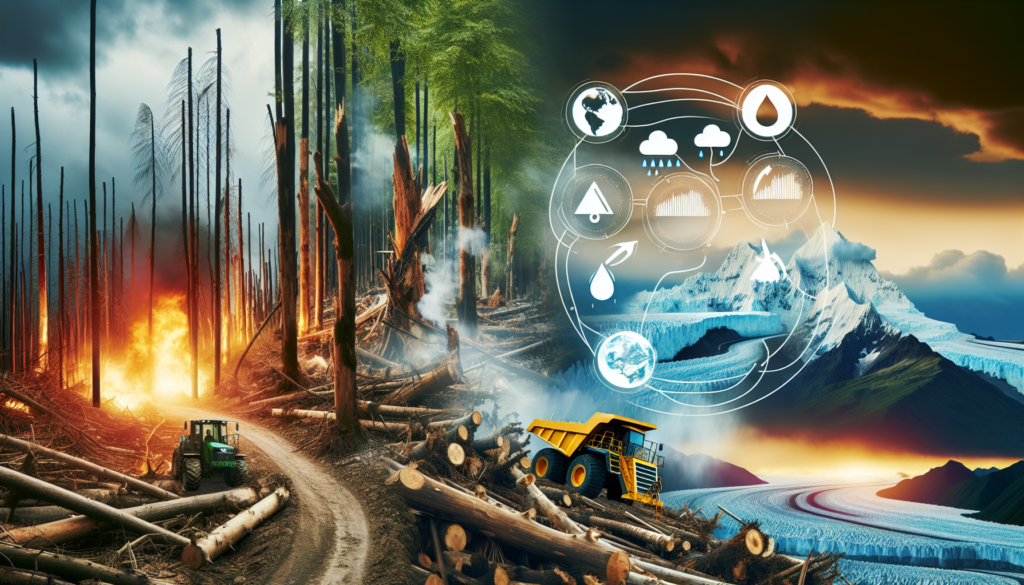In today’s world, it is becoming increasingly evident that our actions have a profound impact on the environment. One such action, deforestation, is not only causing the loss of precious ecosystems but is also significantly contributing to climate change. By stripping away trees and disrupting the delicate balance of our planet, deforestation is altering weather patterns, intensifying greenhouse gas emissions, and threatening the stability of our climate. In this article, we will explore the devastating impact of deforestation on climate change and why it is crucial that we take immediate action to address this pressing issue.

Effects of Deforestation on Climate Change
When it comes to climate change, deforestation plays a significant role in exacerbating the issue. The removal of forests leads to various adverse effects on the environment, causing a chain reaction that ultimately contributes to the warming of our planet. In this article, we will explore the different ways in which deforestation impacts climate change and why it is crucial to address this issue.
Increase in Greenhouse Gas Emissions
One of the primary consequences of deforestation is the substantial increase in greenhouse gas emissions. Forests act as natural carbon sinks, absorbing carbon dioxide (CO2) from the atmosphere through the process of photosynthesis. By cutting down trees, this stored carbon dioxide is released back into the atmosphere. This surge in CO2 emissions intensifies the greenhouse effect, trapping heat and causing global warming.
Moreover, deforestation also leads to the emission of other potent greenhouse gases, such as methane (CH4) and nitrous oxide (N2O). These gases are released from decomposing organic matter and soil disturbance during deforestation activities. Methane, in particular, has a significantly higher heat-trapping capacity than carbon dioxide, making it a major contributor to global warming potential.
Loss of Carbon Sink
Forests serve as crucial carbon sinks, absorbing carbon dioxide and storing it in their biomass and soils. When these ecosystems are destroyed, their capacity to absorb and store carbon dioxide is greatly reduced. Additionally, the destruction of forest carbon stocks during deforestation further diminishes their ability to act as an effective carbon sink. This loss of carbon storage exacerbates the accumulation of greenhouse gases in the atmosphere, intensifying the impacts of climate change.
Altered Water Cycle
Deforestation also disrupts the water cycle, which has far-reaching effects on regional and global climates. Trees play a vital role in regulating rainfall patterns through the process of evapotranspiration, in which they release moisture into the atmosphere. This moisture then condenses and forms clouds, eventually leading to precipitation. However, with the removal of trees, there is a decrease in evapotranspiration, resulting in reduced rainfall and altered rainfall patterns.
Additionally, deforestation affects river flow and runoff. Without trees to intercept rainfall and absorb water through their roots, there is an increase in surface runoff, leading to higher chances of flooding and soil erosion. Changes in river flow can also disrupt ecosystems that rely on specific water levels, impacting aquatic life and the overall health of river ecosystems.

Changes in Local and Regional Climate
The consequences of deforestation extend beyond individual ecosystems and have significant impacts on local and regional climates. With the loss of forests, there is an increase in temperature, as trees provide shade and help regulate temperatures through evapotranspiration. The absence of this cooling effect contributes to the phenomenon known as the urban heat island effect, where urban areas experience higher temperatures compared to surrounding forested areas.
Deforestation also influences precipitation patterns, with studies indicating that deforested areas are prone to decreased rainfall. This not only affects agriculture but also disrupts the natural balance of ecosystems that rely on specific levels of rainfall for survival. Additionally, changes in wind patterns can occur due to the removal of trees, leading to altered climatic conditions.
Enhanced Soil Erosion
One of the less evident consequences of deforestation is enhanced soil erosion. Trees play a crucial role in preventing erosion by stabilizing soil with their root systems. When these trees are removed, the protective cover they provide disappears, making the soil more susceptible to erosion by wind and water. The loss of tree roots also contributes to increased surface water flow, leading to flooding and the washing away of valuable topsoil.
In addition to erosion, deforestation also results in decreased soil fertility. Forests offer a diverse range of organic matter that enriches the soil, promoting its nutrient content and fertility. However, without the continuous input of organic matter from trees, the soil becomes depleted of essential nutrients, making it less productive and hindering agricultural activities.
Loss of Biodiversity and Ecosystems
Deforestation has a disastrous impact on biodiversity and ecosystems. Forests are incredibly rich in biodiversity, serving as habitats for countless species, including plants, animals, and microorganisms. When forests are cleared, this extensive range of species loses their homes and natural habitats, leading to habitat fragmentation and the displacement of species.
Moreover, deforestation disrupts intricate ecological interactions within forest ecosystems. Many species depend on specific relationships within their habitats for survival, such as symbiotic relationships or predator-prey dynamics. With the destruction of these habitats, these interactions are severed, causing imbalances in ecosystems and potentially leading to the extinction of certain species.
The loss of biodiversity due to deforestation also reduces the resilience of ecosystems to climate change. Biodiverse ecosystems are more adaptable to environmental disturbances and have a better chance of withstanding the impacts of climate change. However, with the loss of diverse habitats, ecosystems become more vulnerable, decreasing their ability to recover and adapt to changing conditions.
Drivers of Deforestation
Understanding the drivers of deforestation is essential in addressing this pressing issue. Several human activities contribute to the widespread destruction of forests, each having its unique repercussions on the climate and the environment.
Agriculture and the expansion of croplands are among the main drivers of deforestation. Forested land is often converted into agricultural areas to meet the increasing demand for food production. This expansion involves clearing large areas of forest, leading to the loss of valuable ecosystems and carbon sinks.
Logging and timber extraction also contribute significantly to deforestation. The demand for timber products leads to extensive logging operations, where vast stretches of forest are cut down. This not only eliminates crucial carbon sinks but also disrupts ecosystems that rely on intact forested areas.
Infrastructure development, such as the construction of roads and cities, also plays a role in deforestation. As urbanization and population growth continue, forests are cleared to make way for buildings, roads, and other infrastructure projects. This encroachment on natural habitats further contributes to the loss of biodiversity and disrupts ecosystem functions.
Mining and extraction activities are another major driver of deforestation. The extraction of minerals and resources often requires the clearing of forests to access the desired deposits. This not only causes direct habitat loss but also leads to pollution and other environmental degradation, further contributing to climate change.
Agriculture and Expansion of Croplands
Within the realm of deforestation, agriculture and the expansion of croplands deserve specific attention due to their significant impact on the environment. Forested land is regularly converted to make way for agriculture, resulting in extensive deforestation globally.
Conversion of forested land for agriculture involves clearing large areas of forests to accommodate crops. This process disrupts valuable ecosystems, displaces biodiversity, and releases massive amounts of carbon dioxide into the atmosphere. Additionally, the use of intensive agricultural practices, such as the application of chemical fertilizers and pesticides, further contributes to environmental degradation.
Moreover, the expansion of pastures and livestock production is closely interconnected with deforestation. Forests are often cleared to create space for grazing animals or to cultivate animal feed crops. This not only destroys habitats and increases greenhouse gas emissions but also leads to issues such as soil degradation and water pollution due to large-scale animal waste.
Subsistence farming and slash-and-burn agriculture practices also contribute to deforestation. In some regions, communities rely on these traditional methods of farming to provide for their basic needs. However, the unsustainable nature of these practices, coupled with overpopulation and limited access to alternative techniques, leads to the continuous clearing of forests.
Addressing Key Drivers of Deforestation
To effectively combat the detrimental effects of deforestation on climate change, it is crucial to address the key drivers responsible for this destruction. Various measures can be implemented to promote sustainable practices and reduce the rate of deforestation worldwide.
Implementing policies and regulations that discourage deforestation and encourage sustainable land-use practices is of utmost importance. Governments and international organizations can introduce legislation and provide incentives to protect forests and promote responsible land management. This can include establishing protected areas, implementing reforestation programs, and enforcing stricter regulations on logging and land-use conversion.
Promoting sustainable development practices is vital to strike a balance between economic growth and environmental conservation. Encouraging sustainable agriculture, such as agroforestry and organic farming, reduces the need for extensive land clearance and minimizes the associated environmental impacts. Additionally, supporting initiatives that promote responsible consumption and production can help reduce the demand for goods that contribute to deforestation.
Reducing illegal logging and trade is crucial in combating deforestation. Strengthening law enforcement, implementing traceability systems for timber products, and supporting sustainable certification schemes are effective approaches. This can discourage the demand for illegally harvested timber and promote sustainable logging practices that protect forests from degradation.
Improving land tenure rights and empowering local communities is essential in addressing deforestation. By recognizing and securing land rights for indigenous peoples and local communities, governments can help foster sustainable land management practices. These communities often have a deep understanding of their surroundings and can play a key role in protecting forest ecosystems.
In conclusion, the effects of deforestation on climate change are vast and profound. The increase in greenhouse gas emissions, loss of carbon sinks, altered water cycle, changes in local and regional climates, enhanced soil erosion, and loss of biodiversity and ecosystems all contribute to the accelerated pace of global warming. Recognizing the drivers of deforestation and implementing measures to address them is crucial to mitigate the impacts of deforestation on climate change. By preserving and restoring our forests, we can safeguard the health of our planet and secure a sustainable future for generations to come.

